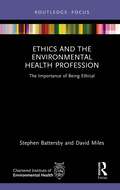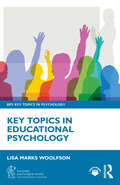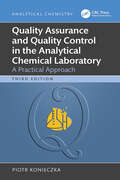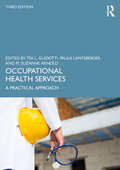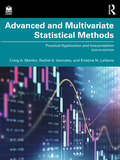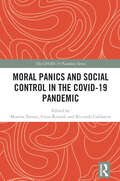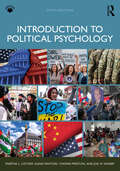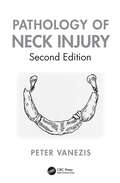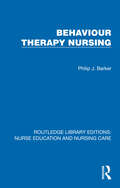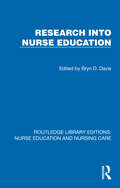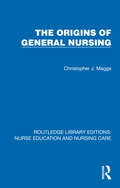- Table View
- List View
American Journal of Archaeology, volume 129 number 4 (October 2025)
by American Journal of ArchaeologyThis is volume 129 issue 4 of American Journal of Archaeology. The American Journal of Archaeology, the journal of the Archaeological Institute of America, was founded in 1885 and is one of the world's most distinguished and widely distributed peer-reviewed archaeological journals. The AJA reaches more than 40 countries and approximately 700 universities, learned societies, departments of antiquities, and museums. The AJA publishes original research on the diverse peoples and material cultures of the Mediterranean and related areas, including North Africa (with Egypt and Sudan), Western Asia (with the Caucasus), and Europe, from prehistory through late antiquity.
Integrative Sport and Exercise Nutrition: A Health-Feeds-Performance Perspective
by Justin Roberts Ian CraigIntegrative Sport and Exercise Nutrition: A Health-Feeds-Performance Perspective defines health as an underpinning requirement for active pursuit and sporting performance. By focusing on the empowerment of scientists and practitioners who support such individuals, this new textbook powerfully disseminates academic and experiential knowledge in a thoroughly applied context. The prevailing paradigm that has existed within the academic enquiry of sports nutrition has typically viewed macronutrients as ‘fuel’ for exercise endeavours. While this notion provides a basis of quantitative nutritional support, what happens when our active individual lacks adequate digestive health to assimilate these foods, and in the process creates an inflammatory tone in their body? And what happens when our aspiring athlete is genetically not suited to the diet that is prescribed by the sports nutritionist, which is based merely on the energetic needs of their sport?The underlying aim of Integrative Sport and Exercise Nutrition is to encourage sport, exercise and nutrition professionals, academics and students to embrace the physiological complexity and individuality of an exercising person. This approach highlights the need to go beyond traditional macronutrient approaches dominant in this field, and consider how our food impacts physiological health from an integrative body systems perspective. Within the context of heavy training loads, often alongside significant life stressors, such practitioners can support the robust health and performance requirements of active individuals. This cutting-edge book thereby brings together the scientific voice of academics with the ‘real-world’ experience of nutrition and exercise practitioners, and by doing so, the authors wish to stimulate a new paradigm of thought towards integrative and personalised thinking in sport and exercise.
Psychoanalysis and the Wisdom of Ecclesiastes: A Time to Heal (Routledge Focus on Mental Health)
by Paul MarcusPsychoanalysis and the Wisdom of Ecclesiastes looks at one of the most profound books in the Hebrew Bible – Ecclesiastes, known as Koheleth in Hebrew – through a psychoanalytic lens.Paul Marcus explores Ecclesiastes’ understanding of the profound and compelling problematics of the human condition and explains how he offers a sensible and feasible attitude toward contemporary life. Comparing Ecclesiastes’ way of looking at life to the Freudian worldview, Marcus suggests what psychoanalysis might in part appropriate or further explore and develop as it tries to enhance itself as a narrative of the human condition and a compelling “technology of the self.” The book also uses psychoanalysis to illuminate aspects of Ecclesiastes that have been underappreciated and undercomprehended.Psychoanalysis and the Wisdom of Ecclesiastes will be of interest to psychoanalysts exploring spirituality and the human condition, and to academics and students of psychoanalytic studies, religious studies, Judaic studies, and philosophy.
A Theological Engagement with Pornography
by Matthew John TanIn Christian circles, consuming pornography has been treated primarily as a moral issue, and the analysis of pornography has dealt with motivations, harms and responses. This book explores how such analyses end up missing important theological dimensions of pornography, and in so missing those dimensions, leave important aspects of the cultural power of pornography unaddressed. The book argues that a purely moral analysis of pornography has led to several presumptions concerning pornography about sex, bodies and the erotic. Working through these presumptions is another, subtler presumption that the act of viewing pornography constitutes an act of viewing proper.This book argues that the Christian tradition can also furnish a theological analysis of pornography as a theological reality, which uncovers these unaddressed dimensions concerning the cultural challenge posed by pornography. In addition, it argues that theology’s vocabulary will also yield surprising analyses that overturn these three presumptions. Ultimately, the book argues that pornography distorts the very act on which it trades, namely the viewing of the sexual act. More specifically, it states that pornography is not sexual, erotic or embodied, arguing instead that it is Christological, mimetic and divinizing. In making these critiques, Christian theology also declares that a properly theological engagement with pornography will involve the transformation of gazing into beholding.
Consumer Collective Redress in EU Law: Lessons from the Polish Legal System (Routledge Research in EU Law)
by Jagna MuchaThis book provides critical insights into the framework of consumer collective redress within EU law, including recent changes introduced by the Representative Actions Directive (EU) 2020/1828. The focus is on Poland, where group proceedings have been operating since 2009. The exploration of Poland’s 15-year time-span experience constitutes a comprehensive case study, offering valuable examples and recommendations.The study examines whether, collective redress mechanisms can ensure effective enforcement of consumer rights and, at the same time, guarantee a high level of consumer protection. The discussion is composed of three fundamental parts. The first chapter explores the nature of collective redress from the perspective of EU law. In the second chapter, the book addresses the various legal mechanisms operating in the Member States and the UK that serve consumers as means of collective redress. The final chapter focuses on Poland, discussing the legislative framework and functioning of group proceedings in practice. The discussion is enriched with specific solutions for the further development of collective redress in the EU.This book covers issues that will be of interest to researchers investigating EU consumer law, collective redress, class actions and law enforcement more in general. It will be of relevance to consumers and practicioners, including attorneys and consumer organisations aiming to bring representative actions in one of the EU Member States.
An Introduction to AI and Intercultural Communication Education (New Perspectives on Teaching Interculturality)
by Fred Dervin and Hamza R’boulAn Introduction to AI and Intercultural Communication Education is the first, historic volume to explore the intersection of AI and intercultural communication education, interrogating both the transformative possibilities and ethical dilemmas posed by emerging technologies.Through diverse scholarly perspectives, the book examines how AI tools, ranging from language models such as ChatGPT and DeepSeek to generative image systems, could reshape the way we teach, research and conceptualise interculturality. While AI offers innovative opportunities for virtual exchanges, automated translation and accessible learning, it also risks reinforcing stereotypes, Western-centric epistemologies and reductive narratives if used uncritically. The contributors address pressing questions: Can AI facilitate decolonial and reflexive approaches to intercultural communication education, or does it inevitably reproduce dominant paradigms? How can educators harness the potential of AI while safeguarding against its pitfalls, such as algorithmic bias and the erasure of indigenous knowledge systems? Combining theoretical critique with case studies, the volume highlights the need for ethical frameworks that prioritise epistemic justice, pluralistic perspectives and human agency in AI-assisted intercultural communication and education.This book is an indispensable resource for students, researchers and educators interested in the complexities of technology-mediated learning, as well as the broader fields of higher education, intercultural studies and internationalisation and globalisation.
Ethics and the Environmental Health Profession: The Importance of Being Ethical (Routledge Focus on Environmental Health)
by Stephen Battersby David MilesProviding an exploration of the discussion on how a stronger ethical basis for the work of environmental health practitioners (EHPs) can contribute to improved public health, because EHPs/environmental health officers (EHOs) come into daily contact with members of the public to address threats to their health and wellbeing. This book examines what is meant by professional ethics and the role of professional bodies in ensuring members of the profession act ethically. They should be expected to act as guardians of the public interest, without fear or favour. Ethics is an integral part of public health decision-making and needs to be incorporated into public and environmental health policy development and decision-making. This work, while seeking to stimulate debate within the environmental health profession, will examine what this means for EHPs.Ethics and the Environmental Health Profession: The Importance of Being Ethical explores the process of ethical decision-making in the environmental health profession and asks the question of whom EHPs have an ethical duty towards in their work. It looks at a variety of ethical issues which arise for EHPs working in local government, as consultants or for commercial companies.This book is useful for EHPs globally, other local government officers, educational establishments where environmental and public health courses are run globally, elected members of local authorities, and policymakers at national and local government levels.
Key Topics in Educational Psychology (BPS Key Topics in Psychology)
by Lisa Marks WoolfsonWritten by an experienced academic and practitioner, this book offers a clear and accessible introduction to educational psychology.The book begins by exploring the history of educational psychology, highlighting key figures in its development and the complex and changing relationship between education and psychology. It examines important theories in the field and provides a discussion of the different methodologies researchers use. Importantly, the book goes on to highlight key impacts of the research on current practice and policy, as well as suggesting emerging areas and future directions for the field. In so doing, it offers a self-contained and easily digestible primer for those studying educational psychology and related disciplines.Key Topics in Educational Psychology is a must-read for undergraduate and postgraduate students of educational psychology, psychology of education, education, and educational studies. It will also be of interest to practitioners in training, particularly those who work in educational settings, including educational psychologists, teachers, therapists, and social workers.
Quality Assurance and Quality Control in the Analytical Chemical Laboratory: A Practical Approach (Analytical Chemistry)
by Piotr KonieczkaThe third edition of Quality Assurance and Quality Control in the Analytical Chemical Laboratory: A Practical Approach defines the tools used in QA/QC, especially the application of statistical tools during analytical data treatment. Clearly written and logically organized, this well-loved volume takes a generic approach applicable to any field of analysis. The authors begin with the theory behind quality control systems, then detail validation parameter measurements, the use of statistical tests, counting the margin of error, uncertainty estimation, traceability, reference materials, proficiency tests, and method validation. The new edition contains fully updated references throughout and includes new information on CRMs and PTs. A new chapter covers calibration and contains numerous new examples, and the subject of accreditation is expanded. Fully updated and revised references New computational examples and solution problems New chapter on Calibration and expanded coverage of Accreditation A practical approach applicable to any field of analysis
Hybrid Intelligence: Merging Collective and Artificial Intelligence to Solve Complex Problems
by Kevin HoltUniquely aimed at teams that think together to solve problems and make decisions, this book explains how to enhance the collective intelligence of a team-size group and combine it with the artificial intelligence (AI) of generative AI to create a hybrid intelligence that is smarter than either one on its own.Boards, committees, and other team-size groups of 5-20 people are the primary problem-solving and decision-making units within organizations, and they form the bridges between organizations, industries, and nations that collaborate on projects. So how can leaders exponentially improve their teams’ capabilities? Assemble the right people, arm them with the right processes, and execute those processes on the right platforms—then add generative AI to enhance those practices. This book describes and synthesizes various ways of increasing a group’s collective intelligence through people, process, and platform practices, and goes on to explain how to augment the practices with generative AI, including how to ask it questions and what questions to ask to obtain superior answers. The resulting upsurge in team capability enables organizations to survive and thrive in a world that is growing progressively more competitive and complex.This book will become the definitive resource for leaders and managers of commercial, government, and nonprofit organizations who want to learn how to significantly improve their teams’ problem-solving and decision-making ability by increasing their collective intelligence and combining it with the artificial intelligence of generative AI.
The End of Roe: The Religious Right’s Regulatory Fight Over Reproductive Rights (Routledge Studies in Religion and Politics)
by Jeanine E. KraybillThe End of Roe assesses abortion and the American legal and political system in the aftermath of the United States Supreme Court’s June 2022 decision in Dobbs v. Jackson Women’s Health Organization.In Dobbs, the US Supreme Court held that a woman did not have a constitutional right to terminate her pregnancy. This decision further polarized an already divided nation by overturning nearly fifty years of precedent under Roe v. Wade, following on from two highly contentious presidential elections. Now, as Christian conservative legal organizations seek to tighten access to abortion through attempts to limit chemical abortion, the most widely used method to terminate pregnancies in the United States, as well as cut off other avenues to the procedure, access to abortion seems uncertain and increasingly complicated across the United States. This book discusses how widely differing abortion laws have evolved across the United States, as well as how religious groups and conservatives have turned to the legal process in their fight to restrict abortion further and how more progressive states have countered with the passage and implementation of safe harbor laws shielding physicians who perform abortions and the women who wish to procure them, mainly when their home state is hostile to their medical situation or choice. This book demonstrates how abortion will continue to shape future elections and the consequences of these political contests on this issue.This book will appeal to students and scholars of American politics, ethics, politics and religion, and women and politics, as well as practitioners in the areas of law, political science, sociology, and philosophy, and anyone interested in the abortion debate in the United States.
Occupational Health Services: A Practical Approach
by Tee L. Guidotti M. Suzanne Arnold Paula LantsbergerThe new edition of Occupational Health Services provides an essential guide in setting up, running, and improving healthcare services either in an organization or within the community. The book offers an invaluable toolkit for the prevention, diagnosis, treatment, and occupational management of work-related health issues.The text covers: An overview of occupational health care in the United States and Canada – how it is organized, who pays for what, how it is regulated, and how workers’ compensation works. It explains how occupational health services are managed in practice, whether within a company, as a global network, in a hospital or medical group practice, as a free-standing clinic, or following other models. The management of core services, including record-keeping, marketing, service delivery options, staff recruitment and evaluation, and program evaluation. It provides details on specific services such as clinical service delivery for injured workers, periodic health surveillance, impairment assessment, fitness for duty, alcohol and drug testing, employee assistance, mental health, health promotion, emergency management, global health management, and medicolegal services. Thoroughly updated throughout and including a new chapter on Consulting, this unique book will be a key reference work for managers and health practitioners from a range of backgrounds, including but not limited to medicine, nursing, health services administration, and physical therapy, as well as students training in these fields.
The Subject of the Nation and his 'Others' in Hindi Cinema: Gender, Religious, Caste, and Ethnic Identity as Difference (Routledge Contemporary South Asia Series)
by MK RaghavendraThis book analyzes the representations of the subjects of Hindi cinema as a way of gaining insights into the hegemony of the upper-caste Hindu male in narratives of nationhood.Given that Hindi cinema has narrativized the nation after 1947, the book examines how these subjects were chosen and argues that they were upper-caste, Hindu and predominantly male. The author's analysis shows asymmetries in the constitution of the ‘imagined nation’ in the public consciousness. Women, the marginalized categories, and minorities were presented as ‘others’ with separate stories for the issues dealing with them—but distinct from that of the nation. Stories centered on women primarily highlight their position within society. In this context, the book argues that it is the male protagonist whose story mirrors that of the nation as allegory.A novel contribution to the field of Bollywood Studies, this insightful work will be of interest to those studying Hindi cinema and film studies, political science and history, as well as gender studies.
Dietary and Medicinal Significance of Wild Edible Fruiting Plants
by Devi Datt Joshi Harendra KharkwalThis book explores the roles of wild edible fruit plants in combating malnutrition and diseases through their use in food and medicine. It delves into the chemical composition of these plants, providing both qualitative and quantitative analyses, and explains how these compounds contribute to their healing properties. This book also provides a detailed presentation of evidence‑based applications in medicine and food supplements. These chapters include pharmacological research on these plants, offering concrete examples of how interactions between different herbs can lead to synergistic or even pleiotropic effects while ensuring the safety of these herbal products. Furthermore, this book highlights the industrial potential of phytochemicals and standardized extracts from these plants, showing their relevance across various sectors, such as cosmetics, food, health, chemicals, and textiles. It also addresses the efficient use of by‑products, emphasizing sustainability. This book presents insights into ethnopharmacology and phytopharmacology and is tailored for researchers, academicians, and professionals in the fields of pharmacology, ethnobotany, and natural product chemistry.Key Features Presents a clear overview of how wild edible fruit plants can be used in medicine and as food supplements Provides an in‑depth qualitative and quantitative analysis of the chemical profiles of wild edible fruit plants Explores the interactions between different herbs, highlighting the synergistic and pleiotropic effects of these combinations Details the industrial applications of phytochemicals and plant extracts derived from wild edible fruit plants Offers valuable insights into the ethnopharmacology and phytopharmacology properties of wild edible fruit plants
Advanced and Multivariate Statistical Methods: Practical Application and Interpretation
by Craig A. Mertler Rachel A. Vannatta Kristina N. LaVeniaAdvanced and Multivariate Statistical Methods, Eighth Edition, offers conceptual and practical insights into multivariate statistical techniques, designed for students without requiring deep technical or mathematical expertise.This updated text facilitates conceptual understanding of multivariate statistical methods by limiting the technical nature of the discussion of those concepts and focusing on their practical applications. It equips students with the tools to critically evaluate research articles that utilize these techniques and prepares graduate students to apply multivariate methods in analyzing their own quantitative data or that of their institutions.This new edition has resources for instructors and students, including an online test bank, downloadable data sets, and “how to” videos of the SPSS procedures, available via the companion website (www.routledge.com/cw/mertler) and signposted throughout the book for easy reference. A brief discussion of practical significance has also been added to Chapter 1.This book is tailored for students taking a multivariate statistics course in graduate programs across a range of fields, including psychology, education, sociology, criminal justice, social work, mass communication, and nursing.
Inviting the Spirit of Play to Transform Trauma: Healing for All Ages
by Monica C. BlumThis unique and accessible book unites leading-edge trauma approaches with the power of playful practice to treat traumatized clients of all ages.Abundant case examples and exercises show new and established therapists how to relationally engage a playful mindset—not play therapy—to accelerate trauma healing and transformation. The book grows up the wisdom embedded in child-based playfulness and grows down complex, adult-focused trauma theory. Readers will discover how to playfully integrate scientifically supported healing principles of Polyvagal Theory, Interpersonal Neurobiology, Coherence Therapy, Accelerated Experiential Dynamic Psychotherapy, Sensorimotor Psychotherapy, and Internal Family Systems, along with broaden-and-build theory, affective neuroscience, structural dissociation, mindfulness, spirituality and more.Most importantly, this book will empower therapists working at the heart of trauma treatment to compassionately hold space for the depth of trauma’s painful, isolating effects while embodying play’s life-affirming, joyful, and transformational qualities to make trauma healing more fun, creative, engaging, and effective.
Moral Panics and Social Control in the COVID-19 Pandemic (The COVID-19 Pandemic Series)
by Morena Tartari Cirus Rinaldi Riccardo CaldareraMoral Panics and Social Control in the COVID-19 Pandemic presents a series of case studies which focus on particular social processes and interactions during the COVID-19 pandemic, applying the tools offered by classical studies on moral panic and moral panic theory to illuminate both political and popular responses.Each case study explores the emergence, development, and impact of forms of moral panic in response to the coronavirus outbreak. In doing so, each chapter addresses the intersectional impact of moral panics upon vulnerable and/or stigmatized groups and outlines how moral panics have informed policies, interventions, and social mechanisms introduced by governments. Incorporating case studies from across the globe and drawing upon approaches from different disciplines, the chapters in this volume offer a wide-ranging and multi-faceted analysis of the varying responses to the coronavirus outbreak.The book highlights aspects of interest for students and scholars in the social sciences, educators, policymakers, and practitioners with an interest in moral panics, responses to the COVID-19 pandemic, and mechanisms of social control.
Psychopathologies of the Living: Selected Essays of Pierre Fédida (The International Psychoanalytical Association Psychoanalytic Ideas and Applications Series)
by Ffrench PatrickPsychopathologies of the Living makes the work of the French psychoanalyst Pierre Fédida (1934–2002) available in English for the first time.Patrick ffrench and Nigel Saint present key essays selected from Fédida’s extensive oeuvre. The book directs attention to two salient dimensions of Fédida’s writing: his attention to the pathologies of the body, considered as both a psychic and somatic entity, and his insistence on the relevance of psychoanalytic thought to the sciences of life. The chapters included in this collection detail Fédida’s creative use of aesthetic sources in his psychoanalytic work, his distinctive and creative manipulation and revision of central psychoanalytic concepts and his precise attention to the texts of Freud, Ferenczi and Winnicott, among others. This selection of Fédida’s essays also shows his avoidance of thematisation or explicit theorisation; for Fédida the theory of psychoanalysis must arise out of the specific interplay of language and the ‘space of the session’.Psychopathologies of the Living will be of great interest to psychoanalysts in practice and in training and to academics and scholars of philosophy, aesthetics and literary studies.
Two Concepts of Rights and the Right to Education
by Yuan ZhengMost rights theories hold that the same act of a person or group cannot be driven by both a right and a duty. This book introduces the theory of initial rights and derived rights, demonstrating that an act is often the result of both. The key idea is that individuals and collectives have the right to fulfill their duty. However, general rights, those people are born with, do not originate from any duty, meaning their choices are not dictated by duties. As a result, access to education is a right, not a duty.The theory of initial and derived rights can extend beyond education to explain broader social dynamics, such as the relationship between government and citizens. This book applies the theory to various contexts, including children’s education, civic and moral education, school– student relationships, and teacher– student interactions. It explores how absolute rights relate to general rights, how the right to education connects to the right to establish private schools, and how opportunities for choice are linked to rights. While this is an abstract theoretical study, it offers practical insights for schools and teachers.The book will be of interest to researchers and students of rights theories and the philosophy of education, as well as educators.
Introduction to Political Psychology
by Thomas Preston Martha L. Cottam Elena Mastors Joe W. HusebyThis fifth edition of Introduction to Political Psychology explores the many psychological patterns that influence individual political behavior. The authors introduce readers to a broad range of theories, concepts, and case studies of political activity, arguing that individuals are driven or motivated to act in accordance with personality characteristics, values, beliefs, and attachments to groups. The book explains many aspects of political behavior—whether seemingly pathological actions or normal decision-making practices, which sometimes work optimally, and sometimes fail.Thoroughly updated throughout, the book examines patterns of political behavior in areas including leadership, group behavior, voting, race, nationalism, terrorism, and war. This edition features: Detailed coverage of political polarization, and the psychology behind it; Up-to-date topics and case studies focused on the 2024 US election, the war in Ukraine, and the Israel–Palestine conflict, as well as social movements such as climate change activism, Black Lives Matter, and #MeToo; A robust suite of timesaving support material. Accessibly written and comprehensive in scope, it is an essential companion for all graduate and upper-level undergraduate students of psychology, political science, and political psychology. It will also be of interest to those in the policy-making community, especially those looking to learn more about the extent to which perceptions, personality, and group dynamics affect the policy-making arena.
Pathology of Neck Injury
by Peter VanezisPathology of Neck Injury, Second Edition is a practical guide and reference to all pathological aspects of neck injury. It covers a broad spectrum of trauma to the neck region, reflecting the experiences of many distinguished pathologists and those of author, Peter Vanezis, who has more than 50 years of expertise in the field. This highly illustrated text begins by explaining the anatomy of the neck region as it relates to trauma investigation and the various techniques required for its examination. Coverage goes on to describe penetrating injuries, comprising mainly sharp force trauma and firearm injuries. Asphyxial and related deaths are subsequently discussed in a series of chapters, before the focus turns to the examination of blunt impact, non‑compressive injuries. Here special reference is made to their common occurrence in road traffic accidents. Finally, this book concludes with environmental, toxic, and iatrogenic causes of injury. Where appropriate, and especially with regard to penetrating and compressive modes of trauma, the interpretation of injuries and their differentiation into various categories such as homicide, suicide, or accident has been addressed. Pathology of Neck Injury, Second Edition is an essential guide for all those involved in the relevant specialties of pathology, surgery, and forensic medicine – particularly pathologists, both qualified and in training, but also to clinical forensic practitioners, trauma specialists, ENT surgeons, and general surgeons.
Behaviour Therapy Nursing (Routledge Library Editions: Nurse Education and Nursing Care)
by Philip J. BarkerThe behavioural approach in nursing practice is the main concern of this book, originally published in 1982. Although the discussion concentrates on the fields of psychiatry and learning disabilities, it is also relevant to other areas of nursing such as the care of the elderly or of sick children. The book traces the development of behaviour therapy from its beginnings in the experimental laboratory work of Pavlov, Skinner and Watson to the more recent influences of social learning theory. A survey is made of the major stages in the therapy process, and this is followed by a detailed description of possible types of treatment. In conclusion some of the more controversial issues raised in this book are reconsidered, along with their implications.
Research into Nurse Education (Routledge Library Editions: Nurse Education and Nursing Care)
by Bryn D. DavisOriginally published in 1983, this book provides a revealing and comprehensive perspective on nurse education in the 20th Century. The opening chapters look at the students themselves: the sort of people who come into nursing and it examines why the drop-out rate is high and how reality differs from expectations. The following section examines teaching on the wards and the final part is concerned with the education and support of those involved in nurse teaching. It includes a discussion of the nature of teaching and of ways of studying the teaching process, as well as analysis of developments in the provision of library and information services to nurse educators, nurse administrators and clinical nursing staff.
Origins of General Nursing (Routledge Library Editions: Nurse Education and Nursing Care)
by Christopher MaggsOriginally published in 1983 this book examines the beginnings of the nursing profession in its present form through one generation of general hospital nurses, Voluntary and Poor Law based, who were recruited and trained between 1881 and 1914. As such, they were the first to go through a co-ordinated and standardised training programme. This study is concerned with the way in which women chose and were chosen to be general nurses and the consequences that their decisions subsequently had for the profession. Unlike previous books on nursing history, this study addresses itself to the history of nursing techniques, to the changing attitudes towards nurses and patients and to the popular contemporary image of nurses over the years.
The Ogress and the Orphans
by Kelly BarnhillA National Book Award finalist and instant fantasy classic about the power of community, generosity, books, and baked goods, from the author of the beloved Newbery Medal winner The Girl Who Drank the Moon. The town of Stone in the Glen used to be lovely, but it hasn&’t been so in a very long time. Once a celebrated town with a vibrant town square, prosperous businesses and families, and educated, happy children, Stone in the Glen has fallen on hard times. Since the expansive and beloved Library burned with other buildings in a time of terrible fires, the town has been plagued by droughts, blight, and destruction. But the people have continued to put their faith in the Mayor, a dazzling fellow with a bright shock of golden hair and brilliant white teeth who promises that he alone can solve their problems. And he is a famous dragon slayer! At least, no one has ever seen a dragon in the Mayor&’s presence… But somebody is to blame for the town&’s problems, not only the fires and the decline that followed them, but the child who has gone missing from the local Orphan House. And with a little helpful suggestion from the Mayor, all eyes turn to the Ogress who has come to live at the far edge of town. Only the children of the Orphan House know the truth. Together, they must clear the Ogress's name and solve the mystery of the town's destruction before their home of Stone in the Glen is destroyed by its own people.






